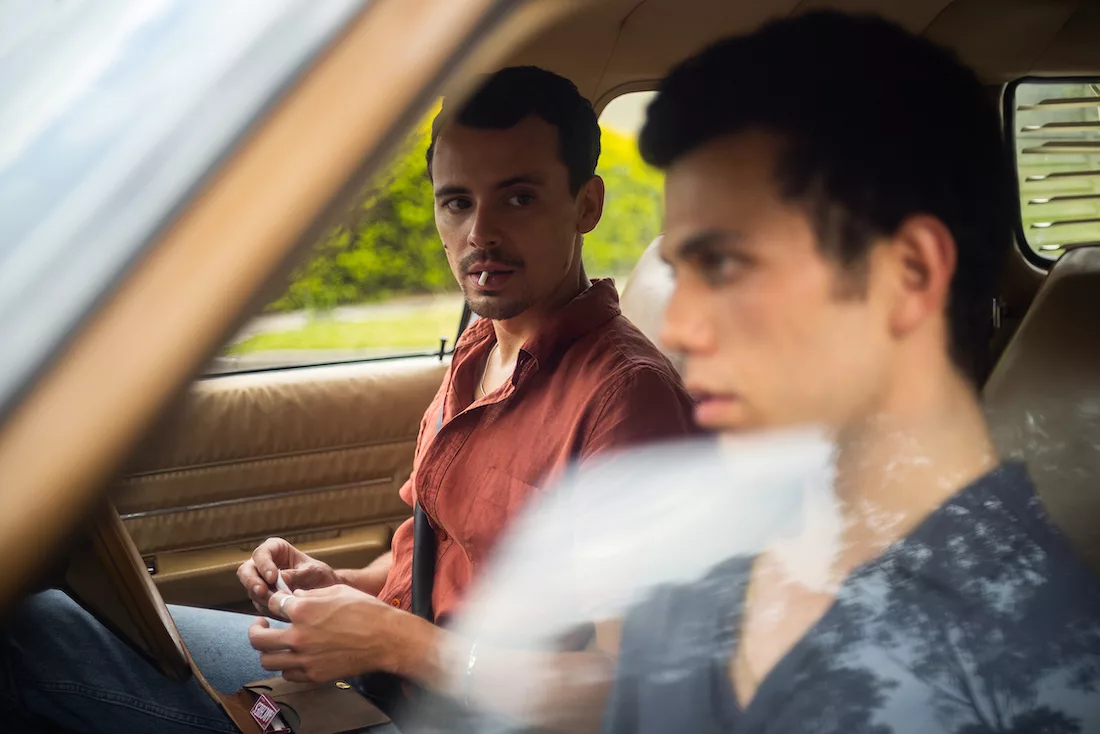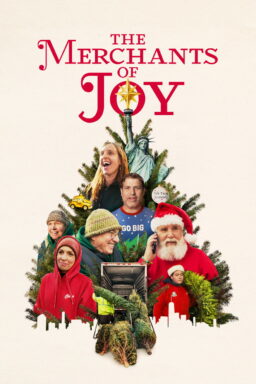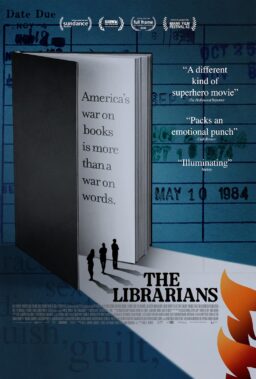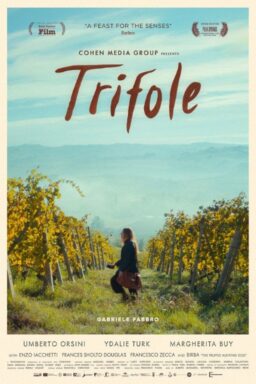The birth of Goran Stolevski’s “Of an Age” surprises the writer/director himself—a cathartic writing session that came in the middle of the night and lead to 75 pages. Drawing from memories of growing up in Melbourne, Australia in 1999, Stolevski tells the story of a young ballroom dancer named Kol (Elias Anton), his dance partner Ebony (Hattie Hook), and her brother Adam (Thom Green). Much of “Of an Age” observes how Kol watches Adam, and vice versa, on a mini road trip to pick up Ebony. The two share a riveting conversation, filled with pauses and gazes that indicate what words cannot. Throughout, the movie owes a great deal to Wong Kar-Wai’s “Happy Together,” which is referenced throughout.
Tempting as it may be, Stolevski cautions against making personal connections. “I’m not a dancer,” he tells me. “I would do it under duress, I would do it badly, and I would avoid it as much as I humanly can.” Still, the film has a lived-through quality that makes it all the more intimate, especially as we follow Kol in this coming-of-age. The film’s center romance is spiked with equal fear and desire for the unknown, and thanks to casting, we get it: Green’s knowing eyes are impossible to look away from.
Stolevski previously directed the Macedonian folk-horror movie “You Won’t Be Alone,” making for a pivot that makes the gentle and meditative experience of “Of an Age” all the more striking. But while Stolevski’s two films may not share the same century or genre, they are united by a fascination in how one transforms when they more or less collide with another. And the films have a similar way of capturing faces of desire, which is all the more effective when it happens between two future lovers one sweaty morning in a car.
RogerEbert.com spoke to Stolevski over Zoom about the making of “Of an Age,” creating chemistry between his co-stars, the film’s many references to Wong Kar-Wai’s “Happy Together,” and more.

I read that this came out of you pretty quickly, the first draft. After now having made the film, why do you think that is?
We actually shot the first draft [laughs]. Life doesn’t happen for me this way, normally. There was no research necessary, I was tapping into a reality that I lived through. Not in terms of the events depicted, I’m not a dancer—never mind ballroom, just nightclub. I would do it under duress, I would do it badly, and I would avoid it as much as I humanly can. The feelings came from the first and only party I went to in high school. Not the event of it, but I had this very vivid flashback of what it felt like on the inside to be that age in that time and place, and what it felt like for me and what I felt love was. And how I thought love would take place, and sex and sexuality.
Most of my teenage years, I wasn’t present mentally. I thought real life happened where Wong Kar-Wai was, where Isabelle Huppert was, where Pedro Almodovar was. The only feelings that mattered were cinematic feelings, and I thought Melbourne 1999 suburbia was the least cinematic place in the world. And I still feel like that a little bit. I just thought, Is there a way I can make feelings from that time and place somehow either fit a bigger film? I finally feel like those films are valid without addressing them or sanitizing them in any way. And for them to feel cinematic for all people, all around the world.
You mention Wong Kar-Wai, and “Happy Together” is referenced multiple times in the movie, by name, by soundtrack, and even with a distinct shot of pluming smoke. What does it mean to you to make those references, and connect your film to “Happy Together”?
In my day-to-day life, in terms of how engaged I with art, I was completely taken away from where I was. The movies I watched were from far away, the music I listened to, which was on the soundtrack, which is from other countries. I feel like to have [“Happy Together”] as an aim, that’s the most intense romance I’ve experienced physically, outside of my day-to-day life. And also “In the Mood for Love.” It’s the longing and aching, and you realize that it’s not the wormholes that make Wong Kar-Wai who he is, it’s the feelings and delving into how deep they are. It’s not like a big canvas.
In Melbourne, I was like, Is there a way to use this city-rustic canvas, suburban Melbourne, 1999? To kind of come up with feelings and a story that can be as intensely romantic. It can match day-to-day life from the outside.
In creating your own Wong Kar-Wai-inspired romance, what was the key to creating chemistry between Elias and Thom?
I feel very lucky now with both of them. There’s this quality where like Elias, like, he doesn’t play vulnerability. He is vulnerable and very comfortable about it; he doesn’t think about it. Feelings just flow out of him. And he searches for connection, he looks through someone else to connect. And what’s rare for a young actor, especially in Australia, is a sense of life lived for them. I rarely see anyone who looks remotely like me—in Australia, multiculturalism happened, but not in the arts. Especially on a socio-economic level, you don’t see people who sound like they went to state school.
I saw Thom in a clip from a film he made called “Downriver,” and it wasn’t a showy Oscar clip with snot and tears. It was just like, guy riding a bike, gets off the bike, goes to a cafe, says “Hi,” and looks at a guy. I admire showy acting, but with no dialogue and just movement, you kind of look like a person who is just living a life, not trying to show me something or being cool. He’s looking at the environment and trying to live off it.
I think chemistry happens out of two people who are just open and looking for connection to start with. Even when they first met, they were clearly … especially with Thom who was older; there’s clearly a sense of making sure the other person feels safe and appreciated. I think in Thom I had a fellow nurturer on set. I think the key to directing is nurturing, more than anything else. There were times when I didn’t get in the way. And with Hattie, this is her first film. The opening scene was her first day on set. No rehearsals, too.

No rehearsals? For anyone?
Rehearsals before the shoot were just sitting around and talking. We weren’t acting out things. I did go through especially with the guys, and Hattie, every single line of the dialogue. I would talk about why I wrote it and explain where I was coming from, just so they were aware. But there was no time for, “Do it this way, or this is what it has to mean.” Because we gave room to skip things, improvise, or embellish, or go back and re-shape. And even on set when I say “Action,” that doesn’t mean “Do it now.” The crew is ready at all times, you can just move around, and we will find you. You can wait for the feelings to come and then act those lines.
What was the biggest challenge in shooting the driving scenes that make up a large chunk of the first half? All of that shooting across from each actor, in those long scenes, I can’t imagine that was easy.
We had a police escort and everything. On a busy road, in 2022 on a budget, creating 1999! [laughs] It was really easy, there was a lot of trying and testing with my cinematographer and production designer, Matthew Chuang and Bethany Ryan, just trying to figure out ways we could cover the scene, so that it was textured visually, but the actors still had freedom.
But then, I think one of the biggest challenges is that the first 18 minutes or so of the film, is that it’s hectic, a very different kind of energy. It’s what adolescence feels like to me. Time feels different. But it’s a turn, and I wasn’t sure how that would work—it’s this slow-paced dramatization of people connecting and honestly when we were shooting, we were pretty hypnotized by the two of them. We had two cameras always running, and the first take probably went 32 minutes. And we’d go back and forth and restart again. I’d reset them back at a certain line, but I found their connection enthralling. I was hoping that would translate on screen, even the way that what they see and how they respond. But I couldn’t cut away from those eyes. It’s impossible. And I’m trying to be in their skin, that nothing existed but the eyes. It became quite simple in the end, surprisingly.
There aren’t too many similarities between this film and your debut, but there’s a continuation of how you shoot faces—profile shots, and silhouettes. What do you feel is the best way about presenting a shot?
It’s not even a cerebral approach—you always want to try to capture the activity and the emotional intensity. When it’s just a sliver of a profile, it’s about when you feel like the rest of you is numb, and just that part of your face exists. And that drives me. Like I’m behind you when I feel like you’re trying to hide something from yourself, as well as me. Or I film you from a distance where you still feel comfortable. You’re presenting a persona, it doesn’t really matter. But you feel like you’re in a safe space, and the camera is not intrusive. Those are the things that drive me, but it’s literally moment to moment. I don’t have an approach.
It reminded me in “Of an Age” of Bergman, those shots of two faces layered on each other, establishing mystery and longing. I know you’re a fan.
F**king hell! Yes, Ingmar Bergman is how I discovered close-ups, but don’t tell anyone [laughs]. But yeah, Bergman is very important in my life.
“Of an Age” is now playing in select theaters and will expand on February 24th.












